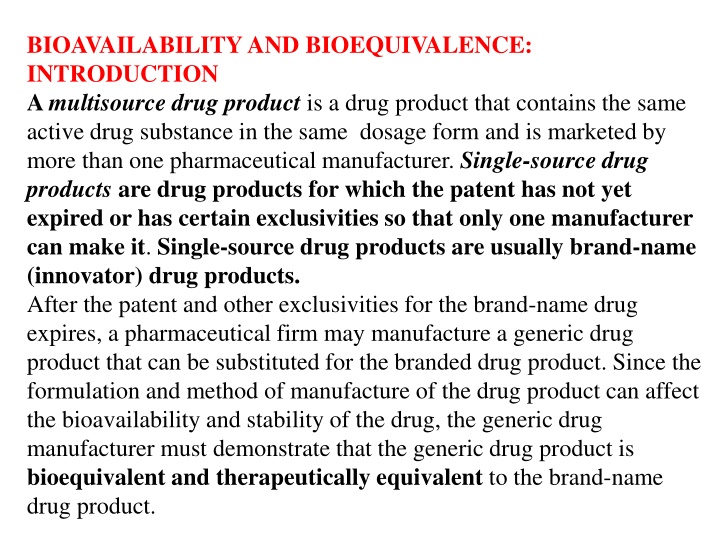
Bioavailability and Bioequivalence in Drug Products
Learn about the significance of bioavailability and bioequivalence in drug products, including how generic drug products demonstrate therapeutic equivalence to brand-name drugs. Explore the role of the FDA's Orange Book in guiding drug product selection and substitution decisions for healthcare professionals.
Download Presentation

Please find below an Image/Link to download the presentation.
The content on the website is provided AS IS for your information and personal use only. It may not be sold, licensed, or shared on other websites without obtaining consent from the author. If you encounter any issues during the download, it is possible that the publisher has removed the file from their server.
You are allowed to download the files provided on this website for personal or commercial use, subject to the condition that they are used lawfully. All files are the property of their respective owners.
The content on the website is provided AS IS for your information and personal use only. It may not be sold, licensed, or shared on other websites without obtaining consent from the author.
E N D
Presentation Transcript
BIOAVAILABILITY AND BIOEQUIVALENCE: INTRODUCTION A multisource drug product is a drug product that contains the same active drug substance in the same dosage form and is marketed by more than one pharmaceutical manufacturer. Single-source drug products are drug products for which the patent has not yet expired or has certain exclusivities so that only one manufacturer can make it. Single-source drug products are usually brand-name (innovator) drug products. After the patent and other exclusivities for the brand-name drug expires, a pharmaceutical firm may manufacture a generic drug product that can be substituted for the branded drug product. Since the formulation and method of manufacture of the drug product can affect the bioavailability and stability of the drug, the generic drug manufacturer must demonstrate that the generic drug product is bioequivalent and therapeutically equivalent to the brand-name drug product.
Drug product selection and generic drug product substitution are major responsibilities for physicians, pharmacists, and others who prescribe, dispense, or purchase drugs. To facilitate such decisions, the U.S. Food and Drug Administration (FDA) publishes annually, in print and on the Internet, Approved Drug Products with Therapeutic Equivalence Evaluations, also known as the Orange Book (www.fda.gov/cder/orange/default.htm). The Orange Book identifies drug products approved on the basis of safety and effectiveness by the FDA and contains therapeutic equivalence evaluations for approved multisource prescription drug products. These evaluations serve as public information and advice to state health agencies, prescribers, and pharmacists to promote public education in the area of drug product selection and to foster containment of health care costs. The following definitions are from the 2003 Orange Book, Code of Federal Regulations, 21 CFR 320, and other sources.
Bioavailability means the rate and extent to which the active ingredient or active moiety is absorbed from a drug product and becomes available at the site of action. For drug products that are not intended to be absorbed into the bloodstream, bioavailability may be assessed by measurements intended to reflect the rate and extent to which the active ingredient or active moiety becomes available at the site of action. Bioequivalence requirement. A requirement imposed by the FDA for in-vitro and/or in-vivo testing of specified drug products, which must be satisfied as a condition for marketing
Bioequivalent drug products. This term describes pharmaceutical equivalent or pharmaceutical alternative products that display comparable bioavailability when studied under similar experimental conditions. For systemically absorbed drugs, the test (generic) and reference listed drug (brand-name) shall be considered bioequivalent if: (1) the rate and extent of absorption of the test drug do not show a significant difference from the rate and extent of absorption of the reference drug when administered at the same molar dose of the therapeutic ingredient under similar experimental conditions in either a single dose or multiple doses; or (2) the extent of absorption of the test drug does not show a significant difference from the extent of absorption of the reference drug when administered at the same molar dose of the therapeutic ingredient under similar experimental conditions in either a single dose or multiple doses and the difference from the reference drug in the rate of absorption of the drug is intentional, is reflected in its proposed labeling, is not essential to the attainment of effective body drug concentrations on chronic use, and is
Brand name. The trade name of the drug. This name is privately owned by the manufacturer or distributor and is used to distinguish the specific drug product from competitor's products (eg, Tylenol, McNeil Laboratories). Chemical name. The name used by organic chemists to indicate the chemical structure of the drug (eg, N-acetyl-p-aminophenol). RELATIVE AND ABSOLUTE AVAILABILITY The area under the drug concentration time curve (AUC) is used as a measure of the total amount of unaltered drug that reaches the systemic circulation. The AUC is dependent on the total quantity of available drug, FD0, divided by the elimination rate constant, k, and the apparent volume of distribution, V D. F is the fraction of the dose absorbed. After IV administration, F is equal to unity, because the entire dose enters the systemic circulation. Therefore, the drug is considered to be completely available after IV administration. After oral administration of a drug, F may vary from a value of 0 (no drug absorption) to 1 (complete drug absorption). Relative Availability Relative (apparent) availability is the availability of the drug from a drug product as compared to a recognized standard. The fraction of dose systemically available from an oral drug product is difficult to ascertain. The availability of drug in the formulation is compared to the availability of drug in a standard dosage formulation, usually a solution of the pure drug evaluated in a crossover study. The relative availability of two drug products given at the same dosage level and by the same route of administration can be obtained using the following equation:
where drug product B is the recognized reference standard. This fraction may be multiplied by 100 to give percent relative availability. When different doses are administered, a correction for the size of the dose is made, as in the following equation: Urinary drug excretion data may also be used to measure relative availability, as long as the total amount of intact drug excreted in the urine is collected. The percent relative availability using urinary excretion data can be determined as follows: where [D u]A is the total amount of drug excreted in the urine.
Absolute Availability The absolute availability of drug is the systemic availability of a drug after extravascular administration (eg, oral, rectal, transdermal, subcutaneous) compared to IV dosing. The absolute availability of a drug is generally measured by comparing the respective AUCs after extravascular and IV administration. This measurement may be performed as long as VD and k are independent of the route of administration. Absolute availability after oral drug administration using plasma data can be determined as follows: Absolute availability, F, may be expressed as a fraction or as a percent by multiplying F x 100. Absolute availability using urinary drug excretion data can be determined by the following:
The absolute bioavailability is also equal to F, the fraction of the dose that is bioavailable. Absolute availability is sometimes expressed as a percent, ie, F = 1, or 100%. For drugs given intravascularly, such as by IV bolus injection, F = 1 because all of the drug is completely absorbed. For all extravascular routes of administration, such as the oral route (PO), the absolute bioavailability F may not exceed 100% (F > 1). F is usually determined by Equation 15.4 or 15.5, where PO is the oral route or any other extravascular route of drug administration.
AUC. The area under the plasma level time curve, AUC, is a measurement of the extent of drug bioavailability . The AUC reflects the total amount of active drug that reaches the systemic circulation. The AUC is the area under the drug plasma level time curve from t = 0 to t = , and is equal to the amount of unchanged drug reaching the general circulation divided by the clearance. For many drugs, the AUC is directly proportional to dose. For example, if a single dose of a drug is increased from 250 to 1000 mg, the AUC will also show a fourfold increase. In some cases, the AUC is not directly proportional to the administered dose for all dosage levels. For example, as the dosage of drug is increased, one of the pathways for drug elimination may become saturated. Drug elimination includes the processes of metabolism and excretion. Drug metabolism is an enzyme-dependent process. For drugs such as salicylate and phenytoin, continued increase of the dose causes saturation of one of the enzyme pathways for drug metabolism and consequent prolongation of the elimination half-life. The AUC thus increases disproportionally to the increase in dose, because a smaller amount of drug is being eliminated (ie, more drug is retained). When the AUC is not directly proportional to the dose, bioavailability of the drug is difficult to evaluate because drug kinetics may be dose dependent.











